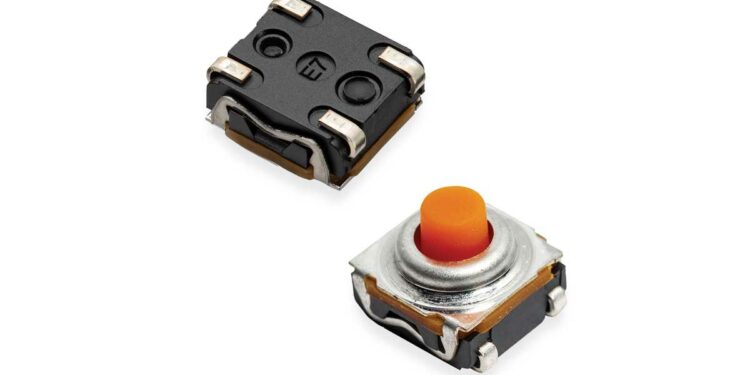Littelfuse unveils potting process friendly tactile switches, rated for up to 1 million cycles, deliver exceptional durability and reliability for high-end consumer, aerospace, automotive, medical, and industrial applications.
Littelfuse, Inc.,a diversified, industrial technology manufacturing company empowering a sustainable, connected, and safer world, today announced the launch of the KSC PF Series sealed tactile switches for surface-mount technology (SMT).
These compact, IP67-rated momentary action switches deliver enhanced environmental protection through a unique extended cage design that simplifies the potting process and improves long-term durability in harsh environments.
Engineered to support rugged applications across industrial, transportation, medical, aerospace, and high-end consumer markets, the KSC PF Series stands out for its compact 6.2 x 6.2 x 5.2 mm footprint, a soft actuator with positive tactile feedback, and superior protection against moisture, dust, and vibration. Its potting-friendly architecture offers engineers greater flexibility when designing electronics for outdoor and mission-critical environments. (View the video in English, Chinese & Japanese.)
While sealed tactile switches are not new to the KSC portfolio, the KSC PF Series is the first optimized explicitly for potting—a process that is rapidly gaining traction across multiple industries. Potting involves fully encapsulating sensitive PCB-mounted components in resin, providing an extra layer of protection against corrosive agents, thermal shock, and vibration. Standard flat cage switch designs typically limit the depth of resin coverage, which can compromise protection. In contrast, the KSC PF’s extended cage enables deeper potting, improves tolerance for resin surface levels, and protects adjacent PCB components—all while streamlining the production process and enhancing product reliability.
“Leveraging decades of Littelfuse engineering expertise, our KSC components, when potted on PCBs, provide our customers with exceptional protection against harsh environments,” said Laurent Kubat, Europe R&D Director, EBU Switches and Sensors, at Littelfuse. “This design approach significantly enhances durability and ensures reliable long-term performance.”
Laurent Kubat added, “The KSC PF Series, with its innovative cage design around the actuator, allows for a higher resin thickness compared to standard versions. This unique feature ensures superior protection for the switch and all components on the printed circuit board, ultimately enhancing the quality and reliability of our customers’ products.”
Key Features and Benefits
- Extended cage allows potting material to fully encapsulate and protect the switch
- Stable performance and proper alignment during the potting process
- IP67-rated sealing against water and dust
- Compatible with SMT automated assembly for efficient high-volume production
- Available in Gullwing or J-bend termination options
- Rated up to 1 million cycles for long-lasting operation
- Maximum power handling of 1 VA @ 32 VDC
Why Potting-Friendly Design Matters
Potting protects sensitive electronics by encapsulating them in resin, shielding them against moisture, dust, vibration, and corrosive elements. However, standard switch designs can hinder the process or limit protection. The KSC PF Series solves this with an extended cage that allows full resin coverage without compromising switch performance. This feature ensures proper alignment during potting, tolerates thicker resin layers, and enhances protection for both the switch and surrounding PCB components. As potting becomes standard in rugged applications—like e-mobility, industrial automation, and outdoor electronics—potting-friendly components like the KSC PF help engineers simplify designs and improve long-term reliability.
For additional information, see the application note, Protection of Electronic Components on Printed Circuit Boards with Potting-Friendly Tactile Switches































